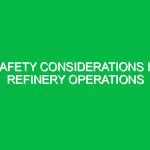Introduction to Process Safety Management (PSM)
Process Safety Management (PSM) is a vital aspect of the Health, Safety, and Environment (HSE) landscape, particularly in industries where hazardous materials are handled. It refers to a systematic approach aimed at preventing the release of any substance defined as a “hazardous chemical” by the Occupational Safety and Health Administration (OSHA). This includes chemicals that can pose significant risks to workers, the public, and the environment.
The importance of PSM cannot be overstated. Every year, industries that handle hazardous processes witness incidents that could have been prevented with robust PSM systems. For instance, the tragic explosion at the West, Texas fertilizer plant in 2013 serves as a grim reminder of the consequences of inadequate safety measures. The incident resulted in 15 fatalities, numerous injuries, and extensive property damage, highlighting the urgent need for effective PSM.
But what exactly does PSM encompass? At its core, PSM integrates various elements, including hazard assessment, employee involvement, and continuous improvement processes, to create a safer working environment. By focusing on prevention rather than response, PSM aims to mitigate risks and promote a safety culture that permeates all levels of an organization.
Identifying Hazards and Risks in PSM
Understanding the potential hazards associated with PSM is crucial for effective management. These hazards can be categorized into several types:
Chemical Hazards
Chemical hazards are perhaps the most apparent risks in PSM. These include toxic, flammable, and reactive substances that can lead to catastrophic events if not properly managed. For example, a chemical reaction that releases toxic gases can endanger workers and the surrounding community.
Process Hazards
Process hazards arise from the design and operation of production processes. This can include equipment failures, human error, and inadequate maintenance practices. A case in point is the BP Texas City Refinery explosion in 2005, where inadequate safety systems and maintenance led to a devastating incident, resulting in 15 deaths and numerous injuries.
Physical Hazards
Physical hazards may include slips, trips, and falls, which can occur in any workplace but are particularly relevant in settings where heavy machinery and hazardous materials are present. Proper training and safety protocols can minimize these risks significantly.
Environmental Hazards
Environmental hazards encompass risks that may affect the surrounding ecosystem due to accidental releases or spills. The Deepwater Horizon oil spill in 2010 serves as a poignant reminder of how industrial activities can have far-reaching impacts on the environment.
Safety Precautions and Best Practices for PSM
To effectively manage the hazards identified, implementing safety precautions and best practices is essential. Here are some actionable strategies:
Conduct Comprehensive Risk Assessments
Regular risk assessments are crucial in identifying potential hazards before they lead to incidents. This involves evaluating processes, equipment, and materials used in operations. For example, a pharmaceutical company might conduct a thorough assessment of its chemical handling procedures to identify areas of concern.
Implement Engineering Controls
Engineering controls, such as safety valves, containment structures, and automated shut-off systems, can significantly reduce the risks associated with hazardous processes. Investing in technology that alerts workers to potential hazards can create a safer environment.
Establish Robust Training Programs
Training is a cornerstone of PSM. Employees must be equipped with the knowledge and skills to recognize and respond to potential hazards. Regular drills, workshops, and refresher courses can reinforce safety protocols and foster a culture of safety within the organization.
Encourage Employee Involvement
Engaging employees in safety initiatives can yield significant benefits. Encouraging workers to share their experiences and insights can lead to the identification of overlooked hazards. Establishing safety committees or holding regular safety meetings fosters a sense of ownership and responsibility among workers.
Adopt a Continuous Improvement Approach
PSM is not a one-time effort but an ongoing commitment to safety. Organizations should routinely evaluate their safety management systems, learning from incidents and near misses to enhance their processes. This approach aligns with the Plan-Do-Check-Act (PDCA) cycle, which emphasizes continuous improvement.
Regulations and Standards Governing PSM
Several regulations and standards govern Process Safety Management to ensure compliance and promote safety. Key among these are:
OSHA’s PSM Standard (29 CFR 1910.119)
OSHA‘s Process Safety Management standard is the cornerstone of PSM regulations in the United States. It outlines the requirements for managing hazardous chemicals in processes and emphasizes the need for a comprehensive PSM program.
EPA‘s Risk Management Plan (RMP) Rule
The Environmental Protection Agency (EPA) enforces the Risk Management Plan Rule under the Clean Air Act, which requires facilities that use certain hazardous substances to develop and implement a risk management plan. This plan must include a hazard assessment, prevention program, and emergency response measures.
International Standards (ISO 45001)
Internationally, ISO 45001 provides a framework for occupational health and safety management systems. While not exclusively focused on PSM, it encompasses elements that support a robust safety culture, including risk assessment and continuous improvement.
Real-World Implications of PSM
The implications of effective PSM extend beyond compliance; they can have profound effects on organizational culture, employee morale, and financial performance. For instance, a company in the chemical industry that prioritizes PSM may experience fewer incidents, leading to lower insurance premiums and enhanced reputational standing.
Conversely, neglecting PSM can lead to devastating consequences. The 1984 Bhopal disaster in India, often regarded as one of the world’s worst industrial catastrophes, resulted from a failure to implement proper safety measures, leading to thousands of deaths and long-term environmental damage. This incident underscored the critical need for robust PSM in mitigating risks associated with hazardous processes.
Conclusion
Process Safety Management (PSM) is an indispensable component of the Health, Safety, and Environment (HSE) domain, particularly in industries that handle hazardous materials. By identifying potential hazards, implementing effective safety precautions, and adhering to regulatory standards, organizations can create safer workplaces and protect their employees, communities, and the environment.
In a world where industrial activities are closely scrutinized, the importance of PSM cannot be overlooked. It is not merely a compliance requirement but a proactive strategy to foster a culture of safety and responsibility. As industries continue to evolve, investing in PSM will remain a critical commitment to ensuring the well-being of all stakeholders involved.


